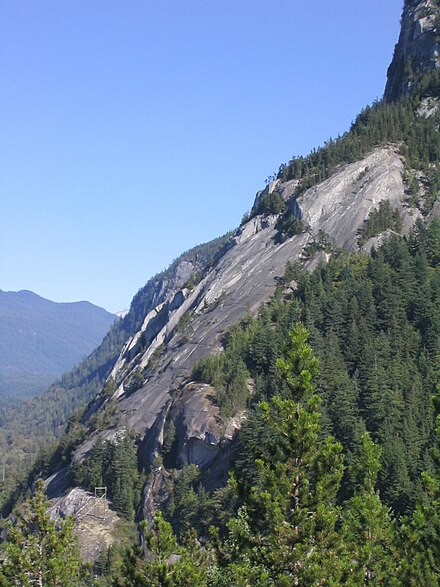Stawamus Chief
The Stawamus Chief, officially Stawamus Chief Mountain[2] (often referred to as simply The Chief, or less commonly Squamish Chief), is a granitic dome located adjacent to the town of Squamish, British Columbia, Canada. It towers over 700 m (2,297 ft) above the waters of nearby Howe Sound. It is one of the largest granite monoliths in the world.[3]
The Squamish, indigenous people from this area, consider the Chief to be a place of spiritual significance. The Squamish language name for the mountain is Siám' Smánit (siám' is usually translated as "chief" though it is really a social ranking), and their traditions say it is a longhouse transformed to stone by Xáays, as the Transformer Brothers are known in this language. The great cleft in the mountain's cliff-face in Squamish legend is a mark of corrosion left by the skin of Sínulhka, a giant two-headed sea serpent.[2]
The mountain gets its name from their village near its foot, Stawamus (St'a7mes), as is also the case with the Stawamus River and Stawamus Lake, though the pronunciation of the village name is different from that commonly used in English (/ˈstɑːʔəməs/ is an approximation of the Squamish language, vs /stəˈwɑːmʊs/ as commonly used in English)[citation needed].
In 1997, the Stawamus Chief Provincial Park was established by the British Columbia Ministry of the Environment. The park is over five square kilometres in area and encompasses not only the Chief but also Slhanay, a slightly smaller granitic dome located a short distance to the north-east. Also featured in the park are a walk-in campground and a number of maintained hiking trails which lead through the forest of the Chief's "backside" to several summit areas.
In the spring of 2009, a new pedestrian bridge was opened across the highway. It provides access to the park from a new southbound parking lot in addition to linking the climbing areas of The Chief with those on the granite faces of Malamute Bluffs. This bridge (officially known as Stawamus Chief Pedestrian Overpass) was built as part of the Winter Olympic upgrades of the Sea to Sky Highway.
The Chief is part of a medium-sized pluton of a granitic rock (granodiorite) that was initially formed in the early Cretaceous (approximately 100 million years ago) by the slow cooling and solidification of molten magma deep below the surface of the Earth.[4]



